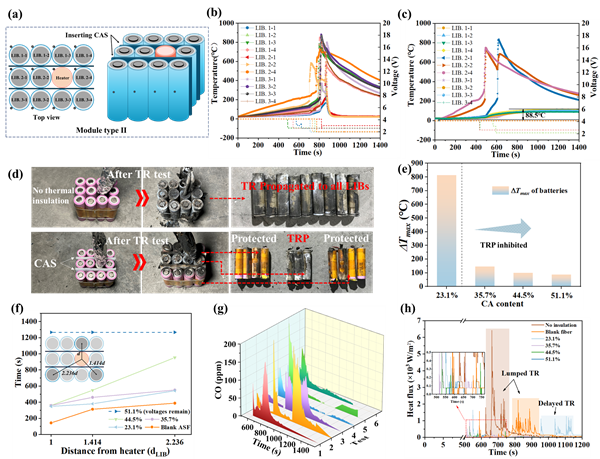
The performance of aerogel sheets in thermal runaway propagation test. (a) The assembly of the LIB modules. (b-c) The time-dependent temperature profiles of each battery during the TR propagation tests with no insulation and aerogel sheet, respectively. (d) Comparison of the LIB module before and after TRP test. (e) The maximum temperatures rise duration of TRP with different aerogel loading. (f) Delayed effect of aerogel sheets compared with the control blank group. (g-h) The reduced CO concentration and flame radiation flux. |
Due to the severe hazards of thermal runaway propagation (TRP) of lithium-ion batteries, separating the lithium-ion battery modules with a highly efficient insulation layer to effectively prohibit TRP, attracting extensive attention from scholars. Aerogel is considered a low-density material with strong thermal-insulation capacity. Nevertheless, silica aerogels or ready-made aerogel materials are not equipped with high-thermal resistance, and the maximum temperature during the thermal runaway of battery modules can be higher than 850 ℃, which will cause structural damage and deterioration of thermal insulation performance. Therefore, developing aerogel sheets with high-temperature resistance and a systematic study of their blocking effects on TRP behaviours are of significant importance for enhancing fire safety of lithium-ion batteries.
Prof. Xudong Cheng, from SKLFS, proposed a type of high-temperature resistant and super elastic aerogel sheet, achieving prevention of thermal runaway propagation in lithium-ion batteries. The thermal runaway blocking effect of the obtained aerogel sheet was experimentally verified. TRP among fully charged LIBs with the highest temperature of up to 836.2 ℃ was successfully suppressed by a 2mm-thick aerogel sheet, yielding the maximum cell-to-cell temperature gap of 767 ℃. The associated work was published in the Energy Storage Materials (the top journal of Chemistry and Physics).
